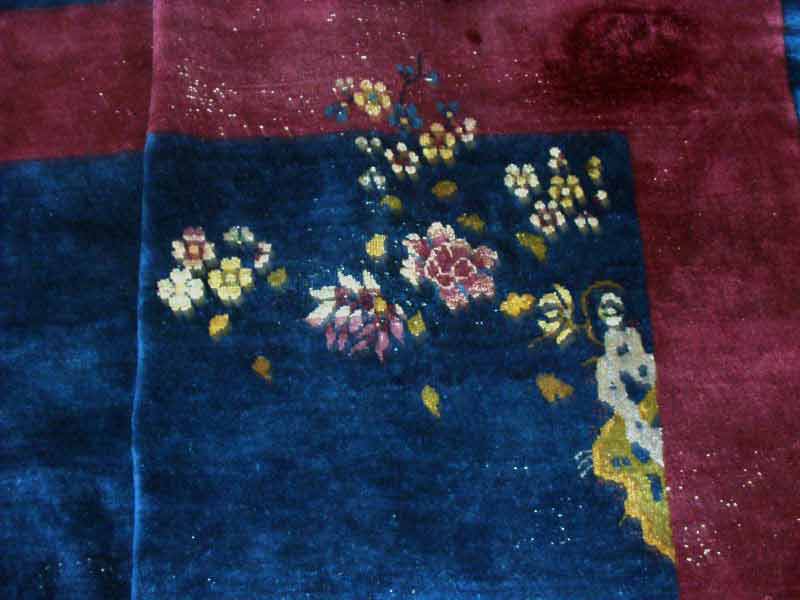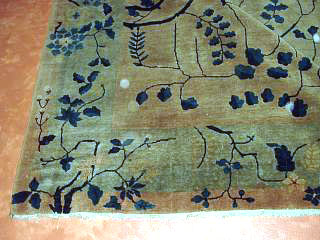Feature Gallery: Chinese Rugs from Art Deco 1930's or Earlier
Jeffrey Lim Associates
Asian Interior Design
Globalhandcrafts.com
Hello! Welcome and thank you for visiting
Globalhandcrafts.com.
Collecting Chinese rugs is not as prevalent as Persian rugs. But take a
second look at some of these examples below. Many Chinese rugs have a
simple and less intrusive design than their Persian counterparts. One
collector loves them for their "Zen" like qualities.
For example take an Art Deco era Chinese rug. There may be just a flowering
branch in one corner and in another corner a Chinese pavilion
with willow trees. The rest of the rug is unadorned with a solid color field.
The border has no ornamentation either. This spartan design evokes a Zen-like
quality that is most appealing.
Of course there are the traditional Chinese design rugs with near perfect
symmetry. Auspicious symbols and patterns are integral to such rugs. The
eight symbols of Buddhism, eight symbols of Daoism, symbols of the four
accomplishments, and the eight precious objects taken from the Hundred
Antiquities all figure prominently in these rugs. Animals also frequently
occur on Chinese rugs. Other motifs such as mountains, water and clouds
occur in more or less realistic shapes. Then there are character symbols
especially the 'shou' or variants of the character for long life.
There are not as many books on Chinese rugs compared to Persian rugs. Any
one of them is required reading should you to want appreciate or be an avid
collector. Unfortunately there are not many dealers who carry
old and Art Deco era Chinese rugs exclusively.
Some other observations. These Chinese rugs are beautiful works of art.
They are highly affordable. They feel like velvet on your feet. And
they are great with any Asian interior design style.
Below are a few examples. Again the pictures do little justice to the
real thing. The rugs are displayed sans other furniture or in any room
setting. That is left to your creative imagination for your own Asian
look. You can email or call should you want to explore possibilities.

CR01: 9'2" x 11'7"
This is a splendid floral composition probably from the 1930s. The flowers
are arranged as nosegays. Strings of colorful ribbons or stylized flowers
reminiscent of origami trail from the nosegays. At the four corners
are floral vases with auspicious symbols like the ruyi sceptre.

CR02: 8' x 9'8"
Here is an example of a sparsely decorated rug. Notice the rich imperial
indigo blue field with a burgundy border. To the top left corner is a vase with
flowers. This floral vase is repeated on the lower right corner.

 The top right corner has floral branches of peony and other species
emerging out of a rock cropping. This ikebana like floral arrangement
simply floats out of the blue field.
At the lower left corner is a Chinese pavilion bridge with a weeping willow
tree (see detail). The rug is very appealing in its spartan design.
The top right corner has floral branches of peony and other species
emerging out of a rock cropping. This ikebana like floral arrangement
simply floats out of the blue field.
At the lower left corner is a Chinese pavilion bridge with a weeping willow
tree (see detail). The rug is very appealing in its spartan design.

CR003: 9' x 11'5"
This rug is circa 1900s. Its origin is Chinese. But the floral sprigs
leaf and fruit tendrils give it a European look. Perhaps it was woven for
export. The dominant color over a beige brown field is the floral sprigs
in rich tones of blue black. The border has tree peony motifs. There
are also butterflies, Chinese symbols of marital happiness.
Note: color difference due to indoor and outdoor lighting.



CR004: 9'11" x 11'10"
Mid to late 19th century. This is a typical Baotou-Suiyuan rug. There are
five even sized floral roundrels on a brocade field. The brocade field has
a damask like look. The floral pattern is repeated at the four corners. An
inner meander border in yellow over deep blue is typical. The outer border
has bats, shou characters, rosettes and flowering sprigs. One other feature
which is quite unusual are the rounded corners. In excellent full pile.



CR005: 8'1" x 9'8"
Another Art Deco example. The floral sprigs float between a plum color
border and a magenta-aubergine color field. The chrysanthemums and
other flowers are in
a bright kingfisher feather turquoise blue. The top right corner spots
a buttefly hovering over the floral branches. Very ikebana floral
arrangements all over the rug. Unfortunately the poor camera lighting
does not show the dark colors well.


CR007: 8'2" x 9'10"
Below are design details from a 1930's Art Deco Chinese rug measuring 8'2" by 9'10".
The design is traditional with a different floral motif in the four corners.
On the top right corner a lantern hangs down with a double happiness
character inscribed. Each corner of the floral patterns are different.
The top right corner also has some cloud band design.
Unlike some Art Deco rugs where there are strong bright colors,
the colors on this rug are earthy and patinated making it easy to blend
and decorate with any style of furnishings.
Shown below are the top left and right corners.
The lower top right corner
has some wear which is expected for an older rug.


The patinated brown border color is repeated in the main field of the
rug. The second border is also a patinated olive green followed by
a deep dark blue. Shown below are the bottom left and right corners
and the middle left side of this rug. Notice the seasonal floral motifs
--tree peony for spring, lotus for summer, chrysanthemum for fall and plum
blossom for winter. The floral arrangements have similarities to ikebana,
the Japanese art of floral arrangement. Even rocks are incorporated to
project a garden setting.



Did you know...
In old China there were five primary colors, each with an equivalent position
on the compass (the center being the fifth cardinal point). Black was north;
blue/green, east; red, south; white, west; yellow, the centre.
Certain colors were reserved for the imperial families: green for the Ming
emperor's family, and imperial yellow for the Manchu clan.
Indigo is the only natural dye that is hardly affected by light or washing, remaining virtually unchanged over the years. It is obtained from Indigofera
tinctoria , which grows in China and India.
Sometimes you will find white 'dots' on a rug. This is what I term snowing.
Most Chinese rugs use a cotton foundation which sometimes expose the ends of two
tied warp threads as white 'dots.' Snowing is more obvious in dark
colored fields. Snowing appeal to collectors just like abrash on Persian rugs.
To learn more about Globalhandcraft.com, our collectibles
and how we approach Asian Interior Design please click to the
following links:
Home: Jeffrey Lim Associates
Asian Interior Design
Portfolio Living/Working with Asian Art
Gallery1 Martaban Jars: The KC Yat Collection
Gallery2 In the Asian Style

 The top right corner has floral branches of peony and other species
emerging out of a rock cropping. This ikebana like floral arrangement
simply floats out of the blue field.
At the lower left corner is a Chinese pavilion bridge with a weeping willow
tree (see detail). The rug is very appealing in its spartan design.
The top right corner has floral branches of peony and other species
emerging out of a rock cropping. This ikebana like floral arrangement
simply floats out of the blue field.
At the lower left corner is a Chinese pavilion bridge with a weeping willow
tree (see detail). The rug is very appealing in its spartan design.















